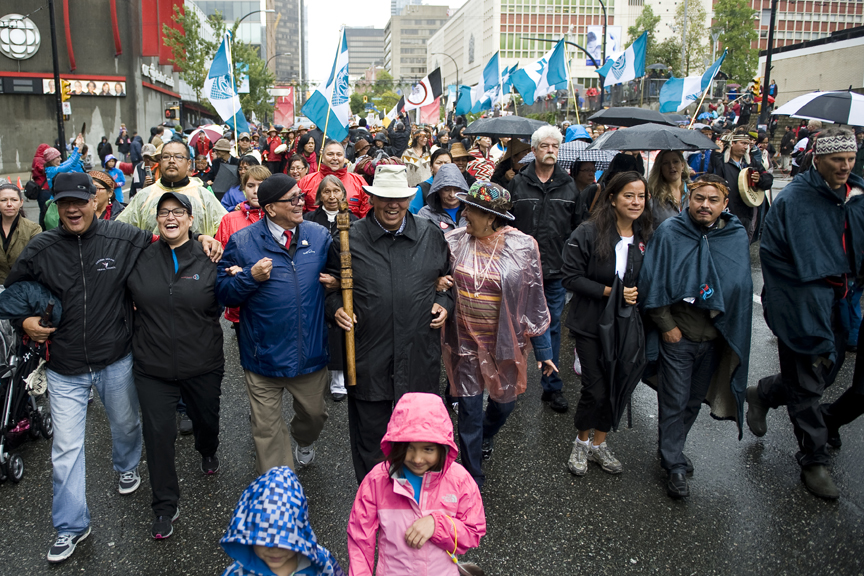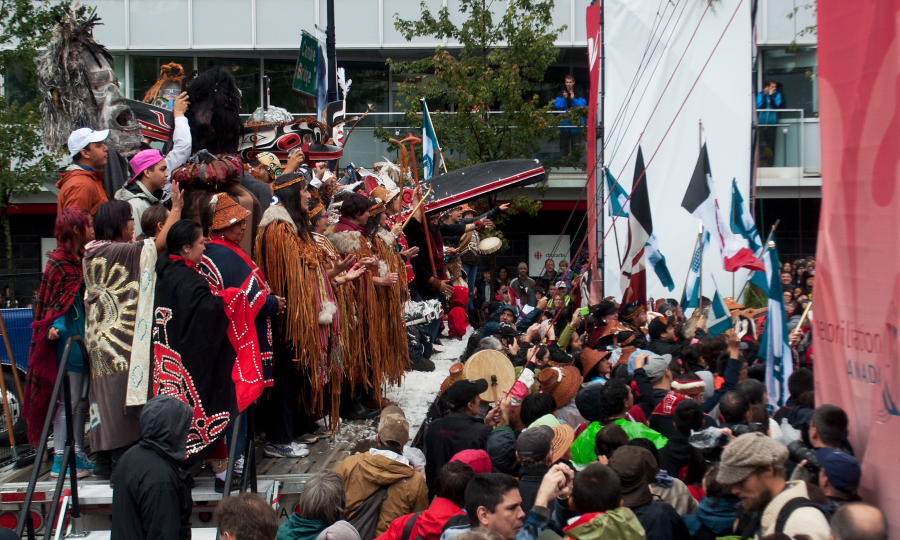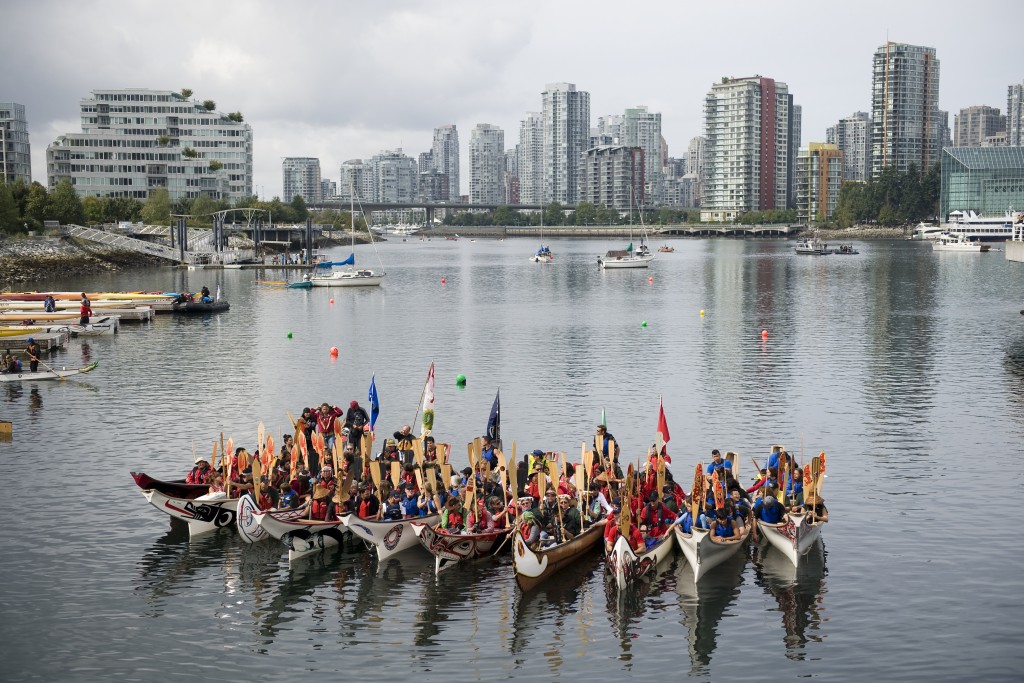Reconciliation Canada wraps up the year with good news!
Dec 19, 2013
Reconciliation Canada wishes everyone a happy holiday season as
we wrap up the year with good news! Read more here.

Reconciliation Canada wishes everyone a happy holiday season as
we wrap up the year with good news! Read more here.
VIMAF 2013 Nov 6 – 11 | 15 events | 6 Days | 4 Venues
VIMAF is a multi-venue celebration of Indigenous digital storytelling, literature, film, technology, and music. The West Coast’s only Indigenous Media Arts Festival showcases prominent indigenous filmmakers, artists, entertainers and authors including Ryan McMahon, Richard Van Camp, Marie Clements, Loretta Todd, Dana Claxton, Klee Benally, Leanne Simpson, Rueben George, Melina Laboucan-Massimo and more. VIMAF seeks to contribute to the culture discourse in independent production and to disseminate Indigenous stories.
Leading up to the festival, drop by the VIMAF salon at Unit #308 – 877 E Hastings st from Monday to Saturday, 12-6pm to enjoy rejuvenating teas, pick up your tickets, get the latest on festival news, and connect with other festival-goers.
The festival launches with the Community Gala Opening at the Vancouver Aboriginal Friendship Centre on Thursday, November 7th. Digital Defence of Sacred Territories From the Haida Nation to the Coast Salish Nations is an evening of media installation, literature and film focusing on land defence. Highlights of the evening include Uts’am/Witness Projects “Picturing Transformation” book launch, a screening of “Athlii Gwaii: The Line At Lyell” documentary, and come play with the interactive digital grafitti wall from Grafitti Research Lab (Canada) remxing #Reconciliation ideas in this Canada Council supported installation.
For full festival schedule and to buy tickets visit www.vimaf.com
by Patricia Marcoccia
Purple, black, blue, polka-dotted and striped — umbrellas of all colours, patterns and sizes covered Queen Elizabeth Plaza and the surrounding streets in downtown Vancouver Sept. 22, as more than 70,000 people participated in the Walk for Reconciliation under a ruthless downpour.
“The grit,” says Paul Lacerte, describing what struck him the most about the walk. The executive director of BC Association of Aboriginal Friendship Centres and a member of the BC Partners for Social Impact (BCPSI) says he was moved by the number of people demonstrating their support and solidarity despite the harsh weather conditions.
“The determination that people have to be a part of this showed me that people know that it’s not going to be easy — the agenda is not easy. It was a signal that people will show up anyway,” he says.
Reconciliation Week began with the lighting of a sacred fire on Sept. 16. A week of truth-telling events culminated in the Walk for Reconciliation. Participants included aboriginal and non-aboriginal citizens — even baby carriages and dogs were spotted in the crowd treading through the wet streets of downtown Vancouver.
The gathering served to acknowledge and cultivate healing of the wounds suffered by more than 150,000 aboriginal children who were forced into residential schools run by the federal government, and Anglican, Roman Catholic, Methodist, United and Presbyterian churches between the 1870s and 1990s. Many students were physically, mentally and sexually abused, and research indicates thatnearly 3,000 children died.
“So many of our elders are passing away without having faced up to what happened to them,” Paul says. “When they don’t heal through that trauma, it just gets passed down intergenerationally. And it’s a bit harder for the next generation to heal because the causal relationship is different — they’ve been traumatized by their parents and so they have to reconcile with their parents.
“Often people don’t understand where that behaviour pattern started — that abuse and neglect and poverty. It gets more complicated, so it’s a necessary process for our communities,” Paul says.
“The fuel that moves people forward is ceremony and culture. People were coming together with a shared desire to have more of a fair society, to reconcile our past and to understand it. To work together in a courageous way to make some change.”
Ahead of the walk, speakers underscored the importance of seeing reconciliation as a Canadian issue, not just an aboriginal one.
Dr. Bernice King addressed the crowd, echoing the need for shared responsibility and collective action. “That struggle is a never-ending process. Freedom is never really won. You earn it and you win it in every generation. There must be persistent, consistent determination to see a new Canada where all people are respected and included in the culture, the economic climate, in the forward moving process.”
Bernice, who is the daughter of slain American civil rights leader Dr. Martin Luther King, underscored the importance of economic empowerment as part of the way forward. She called for leadership action from all fronts in Canada — political and government, faith, educational and community.
Organizations and businesses joined in the communal act of solidarity and support organized by Reconciliation Canada, which is a charitable project established as a collaboration between theIndian Residential School Survivor’s Society and Tides Canada Initiatives Society. Urban Systemsand other BCPSI members participated, including Vancity credit union, which is a founding partner of Reconciliation Canada.
“The BC Partners is exactly the kind of space we need to come together in,” Paul says. The multi-sector collaboration focuses on creating innovative ways to move through intractable systems, processes and issues.
“It’s sometimes unclear what we have to do, but we’re a coalition of the willing and there’s good intention, smart people and resources. Part of the reason why we don’t know what we’re doing yet is because if we knew, we would have already been doing it,” Paul says.
“We’re in a genesis now of, ‘What does reconciliation look like?’ ‘What does a better way of doing business look like?’ ‘What does a better way of treating each other look like?’”
The goal, Paul says, is to create an innovation space where the answers to these questions can bubble up to the surface.
You can comment below or e-mail patricia(at)axiomnews.ca.
Tens of thousands of people braved the weather to participate in the Walk for Reconciliation – A New Way Forward.
From the bottom of our hearts, we thank you for Walking With Us.
Video by Cole Graham

The Walk for Reconciliation was named the #2 Top News Maker of the Year by CBC News Vancouver.
The Walk for Reconciliation is designed to transform and renew the very essence of relationships among Indigenous peoples and all Canadians. It sounds so simple, but just the act of gathering and walking and sharing our stories can join us all in a shared commitment to creating a new way forward in our relationships with each other. Our future depends on being able to simply get along, respecting each other for the unique gifts we bring.
On September 22, communities and individuals from across British Columbia proved that ‘Namwayut — We Are All One is not just a phrase but a sign of social change. Braving the heavy rain to express the determination in rebuilding the relationships among Indigenous peoples and all Canadians, the Walk for Reconciliation was well attended by 70,000 people, including over 300 teams. Among those in attendance included National Chief of the Assembly of First Nations Shawn Atleo, Dr. Bernice King, Dr. Martin Luther King’s daughter, Vancouver Mayor Gregor Robertson, and a delegation of notable government officials and First Nations leaders.
The meaning behind the Walk for Reconciliation
Originally conceived as a healing among Indigenous peoples and all Canadians, in light of the legacy of Indian residential schools, the Walk for Reconciliation is a new way forward. That said, the Walk is foreveryone; it is a walk for peace. It is a chance to reconcile our differences, and our own hearts, for the better good.
The 4 km walk began at Queen Elizabeth Plaza with singing, traditional blessing and speeches from Reconciliation Canada partners and supporters, including a speech from keynote speaker Dr. Bernice King.
But he [Dr. Martin Luther King] knew that hate will destroy the hater more than the hated. So he had no choice but to adopt a higher way if his goal was ultimately to see transformation and change not just in his generation but in generations yet unborn.
Social change cannot come over night yet it causes one to work as if it was a possibility the next morning. I encourage you as you continue to move forward, this is going to be a long journey but every journey begins with a step. Believe it or not, you have made a big step towards progress here in Canada.
Excerpts from Dr. Bernice King’s Speech
Throughout the Walk, walk participants experienced First Nations music and art, including a modern expression of gilskamlił. Traditionally, gilskamlił is a ceremony performed during the potlatch by the Kwakwaka’wakw First Nations—whose territory lies on the north tip of Vancouver Island and the adjacent mainland of British Columbia. The gilskamlił is not a dance, but an intimate sharing of community and spirit.
On the day of the Walk, we witnessed a twist on a sacred storytelling. Curated by artist Beau Dick, this gilskamlił drew upon elements of the ceremonious tradition, but was set in a modern context and inclusive of neighbouring nations—Haida, Musqueam and more—in view of the intent: to lift all people.




Media Reports of the event:
Thousands walk for reconciliation in Vancouver – The Canadian Press, CBC News , October 12, 2013
Reconciliation Week wraps up with Vancouver Walk– Yolande Cole, Straight, September 23, 2013
Thousands brave rain to show support for residential school survivors – Denise Ryan, Vancouver Sun, September 23, 2013

It seemed a little crazy. It was a wet, cold Sunday morning, but for many Vancouverites, the Walk for Reconciliation was an event not to be missed. Many spoke of the important role the Walk for Reconciliation played in their lives.
“It means a possibility and a hope of a new beginning…it means my people, the settler people, listening to the stories of indigenous people, it means indigenous people reclaiming what settler people denied them for so long,” explained Michael Batten, an Anglican priest from East Vancouver. He hoped to express his deep support of the cause of healing and reconciliation.
“I’ve been here [Canada] three weeks,” said Kitty, an exchange student from China. “I went to the TRC the other day and I’m just interested in this history and how Canadian people treat this history.” For many, the presence of Rev Dr Berenice King played a key role in attracting them to the event, but they stayed to watch the performances and soak up the atmosphere.
For Aboriginal youth, participation meant honouring their traditions and the Survivors in their communities.
“Truth and Reconciliation…I wanted to witness this,” Matthew Ambers, of the Kwakwaka’wakw Nation. As the two ends of the Walk seemed to stream endlessly past each other on the Viaduct, participants waved and called to one another as the rain stopped long enough for many to take photos and videos of their fellow walkers.
Len Dennis, a Survivor from Port Alberni, BC, called for more honesty and clarity in the history of the residential schools. He said that he was there with lots of his friends and family. When I asked him how the huge crowds who had turned out for the Walk of Reconciliation made him feel, he had a simple answer.
“Good. Very good.”
For the residential school survivors, the Walk for Reconciliation was a place to come for healing. The distinctive red armbands identified Survivors amongst the thousands who had come to mark this action of reconciliation in Vancouver, hoping for another step in a journey to find peace.
“Healing is the big thing,” Survivor Serena George said, adding that she hoped that all who came would find what they were looking for in the march. George told a lengthy story of her search for healing, motivated to move beyond the abuse of her residential school experience to ensure a better day for her children. She pointed to her family and friends as those who had motivated her to attend counseling.
“Healing…healing to keep going forward and working together, “ Audrey Grant, said. Grant, an intergenerational Survivor, is from the Haisla Nation and said that she was walking to honour her whole family, who are all Survivors.
“My mom is a residential school survivor, and I went to day residential school,” comments Jonathon Thompson, from Hope, BC. He attended the Walk with his family, members of the Chawathil First Nation. Thompson explained, “I like to see everyone come together, you know, we can make it work if we all come together as a collective.”
Although today’s events were merely a single step along a longer journey of reconciliation, the expression of community and collaboration surely will honour the healing path so many have to take.
“It goes back to 1969. I was 14 years old and I stayed for two days in a residential school, St. Michael’s in Alert Bay, which is pretty rare as a young white girl” shared Wendy Kotilla. “I was at an event in the big house. I’ve been interested in first nations culture and people since that time and I think it’s really important for non-Aboriginal people to support residential school survivors because it’s a terrible part of Canadian history and we can all be involved in reconciliation. Walking here together survivors and supporters is something I would not miss. It’s one of the times in my life where I’m most proud to be a Canadian.

On September 17th, 2013, a significant piece of Indigenous culture was shared among Indigenous Peoples and all Canadians. All Nations Canoe Gathering opened the Reconciliation week by inviting Indigenous Peoples and communities in Lower Mainland to participate in a traditional Indigenous ceremony.
The cultural significance of the canoe movement is the resurgence of songs, dances, names, language and teachings. What was dormant for so long woke up with a bang and the people responded. Since the resurgence of the canoes the participation has grown from under 20 canoes in 1989 to present day where there are up to 110 canoes that attend these cultural tribal journeys. Reconciliation Canada recognizes and honors the cultural and spiritual aspects of the dugout canoes and the healing they bring to the people. This canoe day was initiated for Indigenous Peoples to paddle their canoe into False Creek where a traditional protocol of welcome was delivered by local Indigenous hosts. Indian Residential School survivors participated in the water that day and paddled up for protocol for recognition and honor. This was a unique “All Nations” Canoe Gathering that invited Dragon boats and traditional kayaks to join in the day’s event.


See the media links below to watch the beautiful cedar dugout canoes paddle into False Creek from Vanier Park:
All Nations Canoe Gathering Launches Reconciliation Week in Vancouver – Yolande Cole, Straight, September 17, 2013
First Nations canoe gathering marks start of Truth and Reconciliation Week – Kim Pemberton, Vancouver Sun, September 18, 2013
Reconciliation Week starts with All Nations Canoe Gathering– Matt Kieltyka, Metro, September 17, 2013
We are excited to announce that the Reconciliation Canada events are going green and are striving to minimise waste and maximise recycling. We are pleased to say that we have appointed Green Chair Recycling to help us achieve this.
Here are some simple things that everyone can do to help us achieve zero waste:
Bring a reusable drink bottle or cup to use throughout the event.
Why not take it a step further and bring your own picnic set with reusable plates, knives and forks?
Only take what you need! A lot of event waste is from uneaten food and unwanted leaflets and giveaways. Ask for a taste, or a half portion or just say no.
Recycle, recycle, recycle! Clearly labelled recycling stations will be located throughout the events and will be supervised by friendly and knowledgeable volunteers. Take all your waste and recycling to these stations.
Sign up to be a recycling volunteer with Green Chair Recycling (www.greenchairrecycling.com).
27 June 2025, 14:59:57
29 December 2021, 0:00:00
31 December 2021, 23:59:59